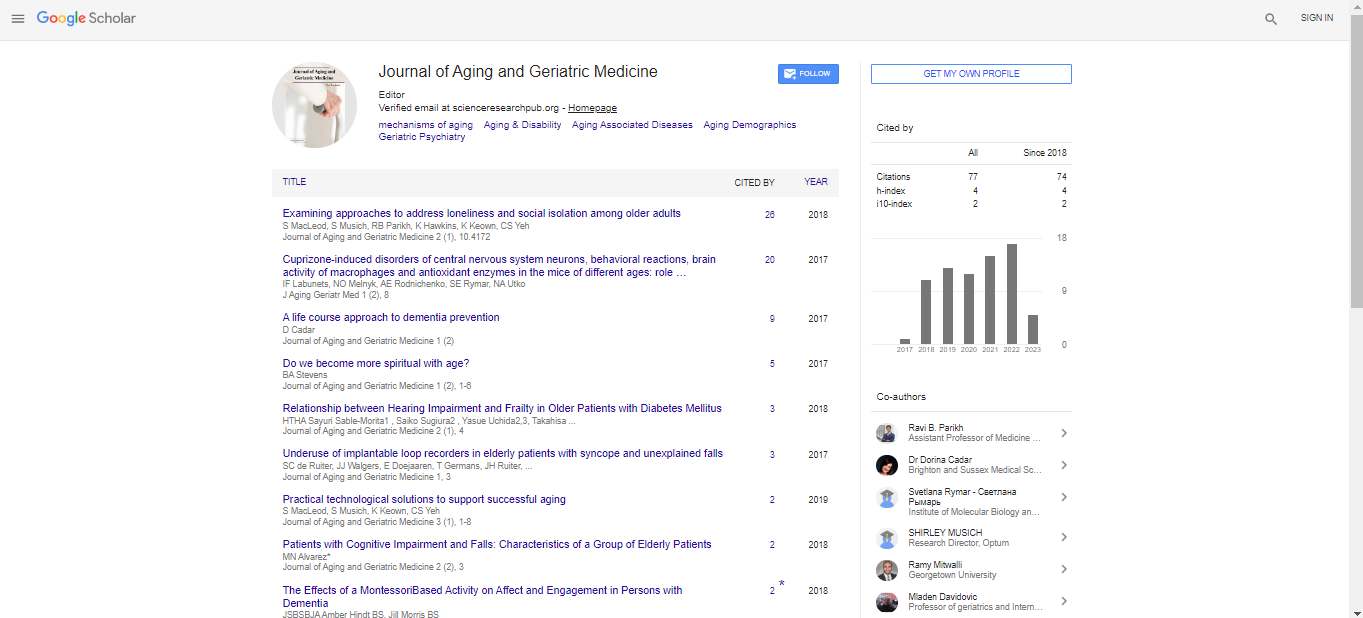Perspective, J Aging Geriatr Med Vol: 7 Issue: 5
Scientific Analysis on Pharmacokinetics and Pharmacodynamics in Aging
Arman Pinto*
1Department of Anesthesiology, Yale University School of Medicine, New Haven, United Sates of America
*Corresponding Author: Arman Pinto,
Department of Anesthesiology, Yale
University School of Medicine, New Haven, United Sates of America
E-mail: arman.pinto@yale.edu
Received date: 28 August, 2023, Manuscript No. AGM-23-117743;
Editor assigned date: 30 August, 2023, PreQC No. AGM-23-117743 (PQ);
Reviewed date: 13 September, 2023, QC No. AGM-23-117743;
Revised date: 21 September, 2023, Manuscript No. AGM-23-117743 (R);
Published date: 29 September, 2023, DOI: 10.4172/2576-3946.1000177
Citation: Pinto A (2023) Scientific Analysis on Pharmacokinetics and Pharmacodynamics in Aging. J Aging Geriatr Med 7:5.
Description
Aging is an inevitable part of the human experience, and as the global population continues to grow older, the field of pharmacokinetics, which studies how drugs move through the body, becomes increasingly relevant. Aging brings about numerous physiological changes that impact the way drugs are absorbed, distributed, metabolized, and eliminated in the body. These changes have significant implications for drug therapy in older adults. As the world's population continues to age, the field of geriatric pharmacology has become increasingly critical. It addresses how the elderly respond to medications and how age-related physiological changes impact drug absorption, distribution, metabolism, and elimination. The scientific analysis of pharmacokinetics and pharmacodynamics in aging, shedding light on the profound implications for drug efficacy, safety, and dosage in older adults. Pharmacokinetics refers to the study of how a drug moves through the body, encompassing its absorption, distribution, metabolism, and excretion. Aging brings a multitude of changes to these processes, influencing drug handling in older individuals. One of the notable changes in absorption with aging is the slowing of gastric emptying, which can delay the onset of drug effects. Furthermore, alterations in gastrointestinal pH and motility may affect the absorption of acidic and basic drugs. These variations in drug absorption can lead to differences in bioavailability, which is the fraction of the administered dose that reaches the systemic circulation. Changes in body composition, including decreased lean body mass and increased body fat, can lead to variations in drug distribution. Many drugs are lipophilic and can accumulate in fat, prolonging their effects in the elderly. Additionally, age-related decreases in plasma proteins, such as albumin, can alter drug binding, potentially increasing the concentration of free, active drug in circulation. Hepatic metabolism plays a central role in drug transformation and elimination. With aging, hepatic blood flow and enzyme activity can decrease, affecting the clearance of drugs. The cytochrome P450 enzyme system, responsible for metabolizing many drugs, can also experience changes, leading to slower metabolism and potential drug accumulation. These alterations may necessitate lower doses for drugs metabolized by this system. Renal function typically declines with age, which can significantly impact drug excretion. Reduced glomerular filtration rate and tubular secretion can lead to prolonged drug half-lives, increased drug exposure, and heightened susceptibility to drug toxicity. Adjusting drug dosages and intervals becomes essential to avoid adverse effects in older adults. Aging introduces several changes in receptor sensitivity, cellular responses, and physiological functions that impact drug action Age-related changes in receptor density and sensitivity can affect drug responses. For example, older adults may require higher doses of medications to achieve the desired therapeutic effect. Conversely, they may be more susceptible to adverse effects due to heightened sensitivity to drug actions.
Geriatric patients often present with multiple comorbidities, which can interact with drug effects. The coexistence of chronic conditions may necessitate a more intricate approach to pharmacodynamics. For example, managing pain in an older patient with both hypertension and osteoarthritis may require considering the potential effects of analgesics on blood pressure. Pharmacodynamics can also impact the central nervous system, which is crucial in the management of neurological and psychiatric disorders in aging. Agerelated cognitive changes can influence drug responses and adherence. Balancing therapeutic effects with the potential for cognitive side effects is a complex challenge. The intricate relationship between pharmacokinetics, pharmacodynamics, and aging has critical clinical implications. Considerations for drug therapy in older adults must address these age-related changes to ensure both safety and efficacy.
Conclusion
Pharmacokinetics and pharmacodynamics in aging are critical factors in the successful management of drug therapy in older adults. Understanding the age-related changes in drug absorption, distribution, metabolism, and elimination, as well as how drugs exert their effects on the body, is paramount in optimizing drug therapy for geriatric patients. Individualized, patient-centered care, regular monitoring, and continued research into geriatric pharmacology are essential to ensure the safety and efficacy of drug therapy in the elderly. As the elderly population continues to grow, the importance of geriatric pharmacology in healthcare cannot be overstated.
 Spanish
Spanish  Chinese
Chinese  Russian
Russian  German
German  French
French  Japanese
Japanese  Portuguese
Portuguese  Hindi
Hindi 